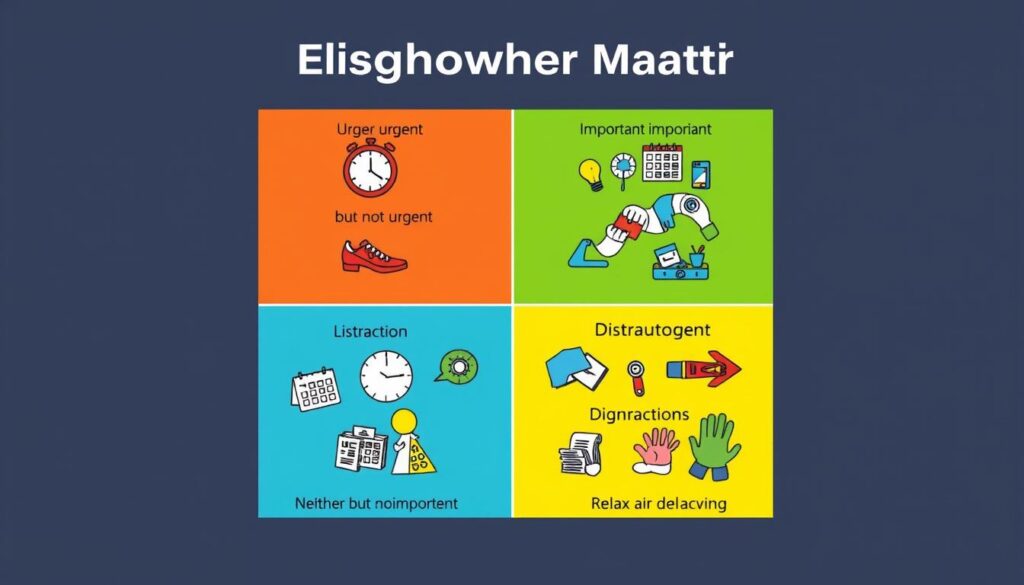Keeping productivity high at work is tough, but it’s key to reaching our goals. By using a few simple strategies, we can do more in less time. This can be done by increasing work efficiency.
One top way to boost productivity is to plan tasks with our natural rhythms in mind. Each person has a prime time when they’re most alert and focused. Scheduling tough or creative tasks then can help us work better and achieve more.
Another great strategy is to focus on the most important tasks first. Instead of doing everything at once, we should tackle urgent and critical tasks first. Tools like the Eisenhower Matrix help sort tasks by importance and urgency, ensuring we’re always on the right track.
There are many other ways to boost productivity at work. We can reduce distractions, avoid multitasking, and group similar tasks. It’s also good to maintain healthy habits, take breaks, and create a great work environment. Using productivity tools, embracing change, and setting realistic goals are also helpful.
Key Takeaways
- Understand your biological prime time and schedule important tasks accordingly
- Prioritise tasks using tools like the Eisenhower Matrix
- Minimise distractions and interruptions to maintain focus
- Batch similar tasks together to improve efficiency
- Take regular breaks and maintain healthy habits to avoid burnout
- Optimise your work environment for maximum productivity
- Embrace a progress over perfection mindset and set realistic goals
Understanding Your Work Rhythms
At track it all, we know everyone’s productivity rhythms and work energy levels vary. These changes are due to our internal clocks, or ultradian rhythms. By understanding these, we can optimise our daily schedules for better productivity.
Identifying Your Biological Prime Time
Finding your biological prime time is key. This is when you’re most energised and focused. Keep a journal for a week to note when you’re at your best. Look for patterns in your energy levels.
Studies show we get distracted quickly, lasting just 12 minutes. By focusing on your peak hours, you can avoid distractions. As management roles change, knowing your rhythms is crucial for success.
“The key is not to prioritise what’s on your schedule, but to schedule your priorities.” – Stephen Covey
Optimising Your Daily Schedule
With your prime time known, you can plan your day better. Here are some tips:
- Do complex tasks when you’re most focused
- Save simple tasks for less focused times
- Protect your peak hours from interruptions
- Take breaks every 90 minutes to stay sharp
Techniques like the Pomodoro Technique can help. It involves working in short bursts with breaks. This boosts productivity and creativity.
Everyone’s rhythms are different. Some are morning people, others are night owls. The important thing is to find what works for you and stick to it.
Prioritising and Planning Your Tasks
Maximising productivity at work starts with prioritising tasks well and planning each day realistically. Focus on the most urgent and important tasks. This way, your efforts are directed towards achieving your goals and using your time wisely.

Creating a Realistic To-Do List
Creating a realistic to-do list is key to managing tasks well. Don’t try to do everything in one day. Instead, pick 5-9 tasks that are both important and doable. This helps avoid feeling overwhelmed and boosts motivation.
When making your daily list, keep these tips in mind:
- Choose tasks that match your main goals and duties
- Break big projects into smaller, easier tasks
- Guess how long each task will take to keep your list realistic
- Be flexible to handle unexpected tasks or interruptions
Creating a realistic to-do list makes your workday more productive and fulfilling. If you struggle to finish your tasks, it’s time to rethink your priorities. Track it all offers tools to help streamline your work and increase productivity.
Using the Eisenhower Matrix for Prioritisation
The Eisenhower Matrix is great for deciding which tasks to include in your daily list. It sorts tasks by urgency and importance. This tool helps you know which tasks to do first, delegate, schedule later, or skip.
To use the Eisenhower Matrix, follow these steps:
- Write down all your tasks and duties
- Put each task into one of four areas:
- Urgent and Important (Do immediately)
- Not Urgent but Important (Schedule for later)
- Urgent but Not Important (Delegate)
- Not Urgent and Not Important (Delete)
- Start with tasks in the “Urgent and Important” area
- Plan tasks from the “Not Urgent but Important” area for later
- Delegate tasks from the “Urgent but Not Important” area when you can
- Get rid of tasks in the “Not Urgent and Not Important” area
Studies show that 80% of your output comes from 20% of your inputs, highlighting the need to focus on high-value tasks.
Using the Eisenhower Matrix helps you focus on the most critical tasks. This approach boosts productivity and helps you reach your goals faster.
| Quadrant | Tasks | Action |
|---|---|---|
| Urgent and Important | Crises, deadlines, pressing problems | Do immediately |
| Not Urgent but Important | Long-term planning, skill development, relationship building | Schedule for later |
| Urgent but Not Important | Interruptions, meetings, some emails | Delegate |
| Not Urgent and Not Important | Time-wasters, distractions, busywork | Delete |
In conclusion, strategic daily planning makes your workday more productive and satisfying. Use tools like the Eisenhower Matrix and make realistic to-do lists. This ensures you stay focused on what’s important, making steady progress towards your goals.
10 Ways to Boost Your Productivity at Work
To boost our productivity at work, it’s key to minimise distractions and create a focused work environment. By using these ten strategies, we can make the most of our time and achieve better results.
Minimise Distractions and Interruptions
First, identify and eliminate distractions. Close unnecessary tabs, silence notifications, and wear headphones to block out noise. A distraction-free workspace is crucial for focus and avoiding interruptions.
Avoid Multitasking
It’s tempting to do many things at once, but multitasking can hurt productivity. Focus on one task at a time to give it your full attention. This way, you’ll produce higher-quality work.
Batch Similar Tasks Together
Grouping similar tasks, like emails or phone calls, helps maintain focus. Batching tasks streamlines your workflow and saves time.
Maintain Healthy Habits
Good physical and mental health is vital for productivity. Get enough sleep, eat well, and exercise regularly. These habits give you the energy and clarity to tackle your workday.
Take Regular Breaks
Regular breaks can actually boost productivity. Short breaks to stretch or breathe can recharge you. Aim for 10-15 minute breaks throughout your day.
Optimise Your Work Environment
Create a workspace that promotes productivity. Keep your desk organised and add things that inspire you. If working from home, have a dedicated work area.
Utilise Productivity Tools and Templates
Use technology to streamline your work. Apps like Trello or Todoist can manage tasks and reminders. Templates save time and ensure consistency.
Embrace Novelty and Change
Introduce novelty and change to keep motivated. Try new techniques, attend workshops, and collaborate on different projects.
Adopt a Progress Over Perfection Mindset
Don’t let perfectionism slow you down. Focus on progress and celebrate small wins. Remember, done is better than perfect.
Set Timeboxes for Tasks
Timeboxing sets a time limit for tasks. This creates urgency and helps stay focused. Break your day into manageable timeboxes for consistent productivity.
At Track It All, we’ve seen big improvements in productivity and job satisfaction. By minimising distractions and using productivity tools, we’ve achieved more in less time. Try these techniques and see how they can change your workday.







